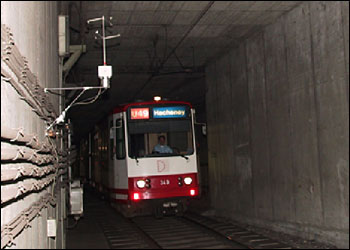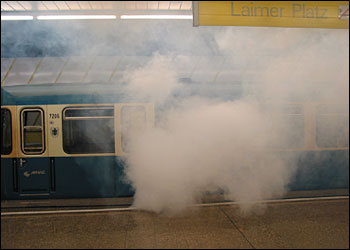Subway Climatology
Development of a safety system for the flexible rescue of passengers in case of a terrorist attack with N/C/B weapons
Until a few years ago the natural airflow regime in subway systems was widely unknown. Accurate information on the conditions of dispersion of airborne hazardous substances in the complex system of tunnels and stations was not available. For this reason I have started research in this field in 1998 and have developed the new research field subway climatology. Also complex and not well studied is the air exchange and interaction with the urban – aboveground – atmosphere. Sufficient knowledge of the underground air flow regime and of the interaction with the external atmosphere is essential for an effective health care regarding questions of bio climate and air hygiene and also for measures of evacuation and rescue in case of disastrous incidences such as fires or terrorist attacks. Current studies are concerned with the development of a safety system, which will allow the diagnosis and evaluation of an emergency situation and supply information for decision makers. This will help to plan the rescue and evacuation procedures concerning questions as to where to concentrate the rescue teams, identify the most endangered areas and provide an adaptive escape route system for the passengers.

Airflow and air temperature measurement in the Dortmund subway
In a pilot study in the subway of Dortmund a new airflow measurement instrument was developed on the basis of an ultrasonic anemometer. The new instrument analyses the current airflow data and suppresses the influence of train service on the airflow conditions. This makes it possible to asses the current background airflow regime, which is crucial for the dispersion of airborne substances, after train service is stopped in case of an incident involving smoke or other hazardous substances.
Bio climatic conditions in subway systems
In a subway system, electromagnetic radiation is reduced to thermal radiation emitted by the floors, walls and ceilings, as well as electrical installations, air conditioning systems, operational facilities, trains and passengers. Thus air temperature is regulated by heat exchange with the surrounding surfaces and air exchange with the outside atmosphere. Air temperature and humidity conditions inside a subway system regularly differ from outside atmospheric conditions. Passengers normally adapt their clothing to outside conditions, so the transition between subway system and outside atmosphere can put a physical strain on them. The analysis of this situation and possible solutions are the goals of this project.

Smoke test in the Munich subway

